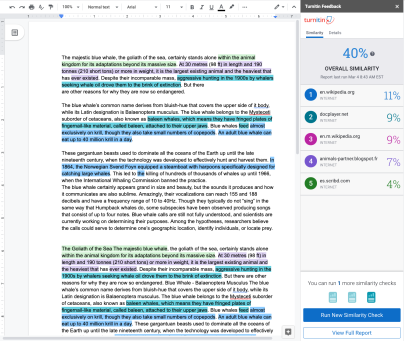Understanding your similarity report
Interpreting the report
Turnitin is known for searching student submissions for matches against our extensive database. If instances are found where a user's writing is similar to or matches against a source this will be flagged for your review in the match overview.
The database includes billions of web pages: both current and archived content from the Internet, a repository of works students have submitted to Turnitin in the past, and a collection of documents, which comprises thousands of periodicals, journals, and publications.
The percentage of the similarity score is based on the amount of matching text in a document. It is perfectly natural for an assignment to match against some of our databases. If you've used quotes and referenced correctly, there will be instances where we will find a match and that is totally OK! The similarity score simply highlights any matching areas in your paper so your teacher can use this as an investigative tool to determine if the match is or is not acceptable. Each match is highlighted and color-coded to make it easier to distinguish between multiple possible matches.
What is a ‘good’ or ‘bad’ similarity score?
There is no fixed number to receive as a score in your Turnitin Similarity Report. However, your school or teacher may have assigned a certain number as the acceptable threshold for assignments. Consult your teacher for details on this threshold. Some similarity is usually expected and can simply mean that you have included source-based evidence which is a requirement for some assignments. If you have concerns or questions regarding any aspect of your similarity score, your teacher will be able to advise you.
What can I do with the information in the report?
The information in your Turnitin Similarity Report should help you make decisions about how to improve your writing, whether that is in later drafts of the same assignment or on future assignments of a different nature. If you have the opportunity to revise your writing based on your Similarity Score, consider the following:
-
choose only the most significant quotes to include from your sources
-
summarize, paraphrase, or explain an idea in your own words rather than quoting it directly
-
cite all of your evidence using the appropriate citation style
